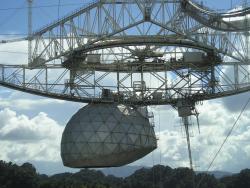The Arecibo Observatory has the largest radio telescope ever constructed. Maintaining the greatest electromagnetic wave gathering capacity of any telescope, it has been an essential tool in modern astronomy, ionosphere and planetary studies. Several feats of mechanical engineering went into the construction of this observatory, most notable of which is a drive system which allows all active parts of the antenna to be kept focused with millimeter precision regardless of environmental factors—such as thermal expansion.
Telescope

YearAdded:
Image Credit:
Image Caption:
NAIC/Arecibo Radiotelescope
Era_date_from:
1963
2001

The increased light-grasp of this telescope made possible many notable advances in structural cosmology between 1924 and 1930, which have revised our ideas about the universe. One of these advances was that spiral nebulae are galactic units like our own; another was the idea of an expanding universe. George Ellery Hale began planning this project in 1906; Francis G. Pease was the chief designer and mechanical engineer. The telescope's mirror support and the use of mercury flotation to reduce the friction are among its outstanding mechanical engineering features.
YearAdded:
Image Credit:
Courtesy Flickr/Bruce Irving (CC BY 2.0)
Image Caption:
Mount Wilson Observatory, 100-inch Hooker Telescope
Era_date_from:
1918
1981

The increased light-grasp of this telescope made possible many notable advances in structural cosmology between 1924 and 1930, which have revised our ideas about the universe. One of these advances was that spiral nebulae are galactic units like our own; another was the idea of an expanding… Read More

The Arecibo Observatory has the largest radio telescope ever constructed. Maintaining the greatest electromagnetic wave gathering capacity of any telescope, it has been an essential tool in modern astronomy, ionosphere and planetary studies. Several feats of mechanical engineering went into the…
Read More

